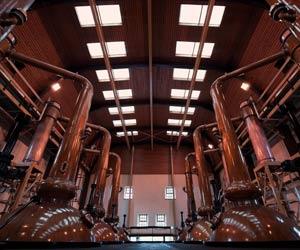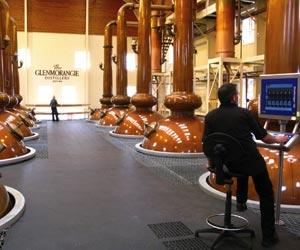The Glenmorangie distillery

Though Glenmorangie is close to the sea - it can actually be seen from its courtyard - this doesn’t play a determining role in the malt’s character. In fact, the east coast of Scotland is much milder and calmer than the west coast which is swept by salty sea winds. Indeed, the area is so calm it is known as the “glen of tranquillity”, a translation of the name Glenmorangie.
The stills, on the other hand, do play an essential role in the aromatic profile of its single malt. Their unusual shape includes an almost spherical base and a long neck sometimes over five metres high. Due to the huge reflux this creates, the distillate produced is light and especially aromatic.
In 1843, the founder of the distillery bought two stills from a gin distillery. And despite the introduction of six new stills following extensions in 1979 and 1990, the shape and size of the original models has always been scrupulously reproduced.

Glenmorangie’s other special feature is its use of mineral-rich hard water from the Tarlogie spring, which is located on land bought by the distillery in order to guarantee its supply of high-quality spring water. A vast finishing programme has been set up at the instigation of Bill Lumsden, who was first the director of the distillery and then became head of maturation for the group’s three distilleries.
Perhaps it was because of its location close to the town of Tain that Glenmorangie began moving towards wine-cask finishes in the 1990s, even producing two versions finished in Hermitage rouge casks!